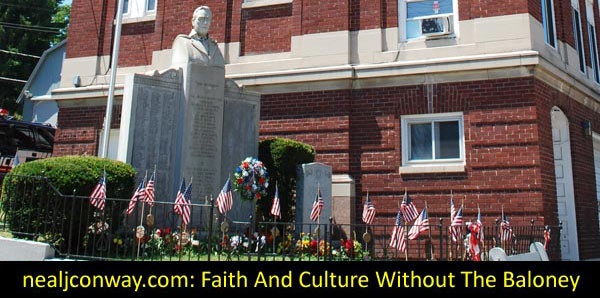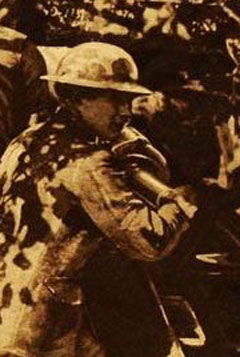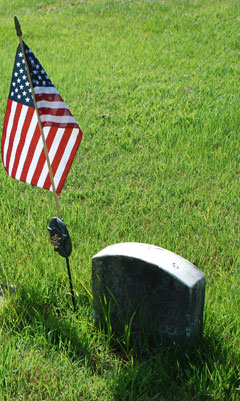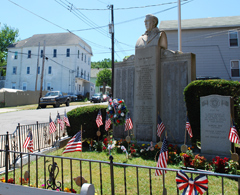
Martin Leo Conway and The Boys From Sugar Notch
(May 28, 2012; Revised Nov. 6, 2013)
In 2012 a distant relative sent me the poem at right. It was written by a World War I vet named J.H. Kenney from Sugar Notch, PA, in praise of his hometown friends who had fought in that war.
The men mentioned in the poem served in various branches of the military: Marines, Air Corps, Navy. One named Durkin was apparently promoted to lieutenant from the ranks. It reads as if his superior officers were all killed and that he was the highest ranking man in the situation.
Among the Sugar Notchers were a couple of honorary Irishmen, "Joe Reilly, little Polish Joe" and Meyer Levinsky, "an Irish Jew." Crudely expressed though they may be, these are words of respect, affection and admiration of the valor of members of immigrant groups who had arrived after the Irish and who therefore had been generally looked down upon.
Last praised is a Sugar Notcher who was killed, Mart Conway. He was my Great Uncle Martin Leo Conway. I will return to Mart following some background.
J.H. Kenney's poem about Sugar Notch veterans reminds me a lot of the 1940 movie The Fighting 69th starring James Cagney as a Bowery tough and Pat O'Brien as Fr. Francis P. Duffy, chaplain of the 69th New York Regiment. A memorial to Duffy, the most decorated military chaplain in history, stands amidst Times Square's throngs and assaults on the senses.
The 69th New York also had a poet in one of its sergeants. His name was Joyce Kilmer. Before going off to war, Kilmer, a convert to Catholicism, penned the best known opening couplet in American poetry: I think that I shall never see / A poem lovely as a tree.
Among the predominantly Irish 69th soldiers there were also those who were non-Irish. Some of them, probably out of fear for personal safety, adopted Irish names. Misha Moskowitz called himself "Mike Murphy." Perhaps that's what "Joe Reilly" in the Kenney poem did as well.
In World War I, state-based National Guard regiments such as the 69th New York were absorbed into huge divisions of 10,000-30,000 men. These divisions officially had number designations but were also variously nicknamed The "Rainbow Division" (42nd Infantry) and "The Big Red One" (1st Infantry).
Some of the men wriitten of in the Kenney poem served in "The Old Hickory Division." Its official title was The 30th Infantry Division and it was called "Old Hickory" because it was formed in Andrew Jackson's Tennessee/North Carolina neighborhood.
The history and movement of these divisions is very confusing, I think, in part because World War I involved fighting back and forth across Northern France. However in July,1918, in The Second Battle of The Marne, the allied forces of France, the U.S. and The British Commonwealth began to push the German army away from Paris and back to its homeland.
July, 1918 was the month that Trees poet, Joyce Kilmer was killed in battle.
Next to the 42nd at The Marne was the 3rd Infantry Division wherein Martin Leo Conway served in an artillery battalion. That division became known as "The Rock of The Marne" because it played a crucial role in the repulsion of the Germans from France's capital city.
However the distinction came at a horrible price. World War I was the first war of mechanized butchery. All manners of killing were tried including chemical weapons. Both the Germans and the allies used them. The most commonly deployed was an airborne blistering agent, mustard gas.
As the war progressed, the combatants realized that poison gas was impractical and a cause of environmental disaster. Why saturate with deadly chemicals territory that you hope to capture? Nevertheless in The Battle of The Marne, the desperate Germans released poison gas and they released it on Martin Conway and the men of the 3rd Infantry Division.
In late September of 1918, the War Department released a long list of war casualties -- by no means complete -- that had occurred over the summer. This list was published in papers around the U.S. and took up most of the 32.5 x 22.5-inch sheets that news was printed on at the time. Martin Leo Conway of Sugar Notch, PA was on the list.
In two papers that I have examined, Martin was listed under "Severely Wounded." However The Ogden [UT] Standard, either by mistake or arbitrarily, inserted the subhed "Missing in Action" before Martin's name and several hundred others.
I suspect that the innacurate casualty designation was deliberately done by the paper's editors. World War I occasioned an era of repression, censorship and propaganda that has been seldom seen in U.S. history. Early in the war, motion pictures of battles were banned because they showed so many soldiers being slaughtered. I think that someone connected with The Ogden Standard wanted to conceal the fact that so many men were being killed and severely wounded. Bisecting the list with "Missing In Action" made the war look less terrible.
Unlike its depiction in movies, poison gas was not instantly fatal nor did it kill most who were exposed to it. The gas burned the moist parts of the body, the eyes, the lungs. Soldiers affected by it, such as Adolf Hitler on the German side, usually experienced temporary blindness or pneumonia-like symptoms which healed in time.
However others breathed in doses of blistering agents that were heavy enough to do severe lung damage. These casualties lived only a few years after the war. In his book Duffy's War (1) about the New York 69th, Stephen L. Harris writes that "no one will ever know how many unfortunate souls, after returning to The United States, later died of complications from the gas they inhaled on the battlefield."
Martin Leo was one of those. He lingered long enough after his mustard gas injuries to be brought back to Sugar Notch. He is buried in the family plot in St. Charles Cemetery. His twin brother, Hugh, lived until 1969.
Poison gas was such a terrible, lose-lose weapon that in the 1920s Geneva Protocol signatories agreed to avoid using it in future wars. Chemical weapons were not deployed in World War II. Ironically, because of his gas injury, Adolph Hitler was against fighting with them.
Thanks to John Patterson for bringing J.H. Kenney's poem to my attention. This page will be updated with more about Martin Leo Conway and the other veterans from Sugar Notch after information becomes available.
(1) Stephen L. Harris, Duffy's War: Fr. francis Duffy, Wild Bill Donovan and the Irish Fighting 69th in World War I, Potomac Books, Inc., Washington, DC, 2006.
In World War I, poetry was a commonly read and appreciated literary form. Soldiers' poems about battles, including verse by professional poets such as Joyce Kilmer and Englishman Wilfred Owen, were published in Stars and Stripes and newspapers. From Sugar Notch was published in a Wilkes-Barre paper several years after the armistice of Nov. 11, 1918. From Sugar Notch by J.H. Kenney |
 |
| From a U.S. Army official photo: a close-up of an unidentified 3rd Infantry Division artillery man, as Martin Leo Conway was, near The Marne River in 1918. |
 |
| Martin Leo's grave in the Conway family plot at St. Charles Cemetery in Sugar Notch. |
 |
| The Sugar Notch memorial honoring vets from World War I to the Persian Gulf. The large Word War II portion was personally dedicated by Eleanor Roosevelt. |
| Also by Neal J. Conway: A World War 2 Love Story |
Copyright 2012, 2013 by Neal J. Conway. All rights reserved. About this site and Neal J. Conway nealjconway.com: Faith and Culture Without The Baloney |